Big Data in Agriculture: From Data Collection to Strategic Action
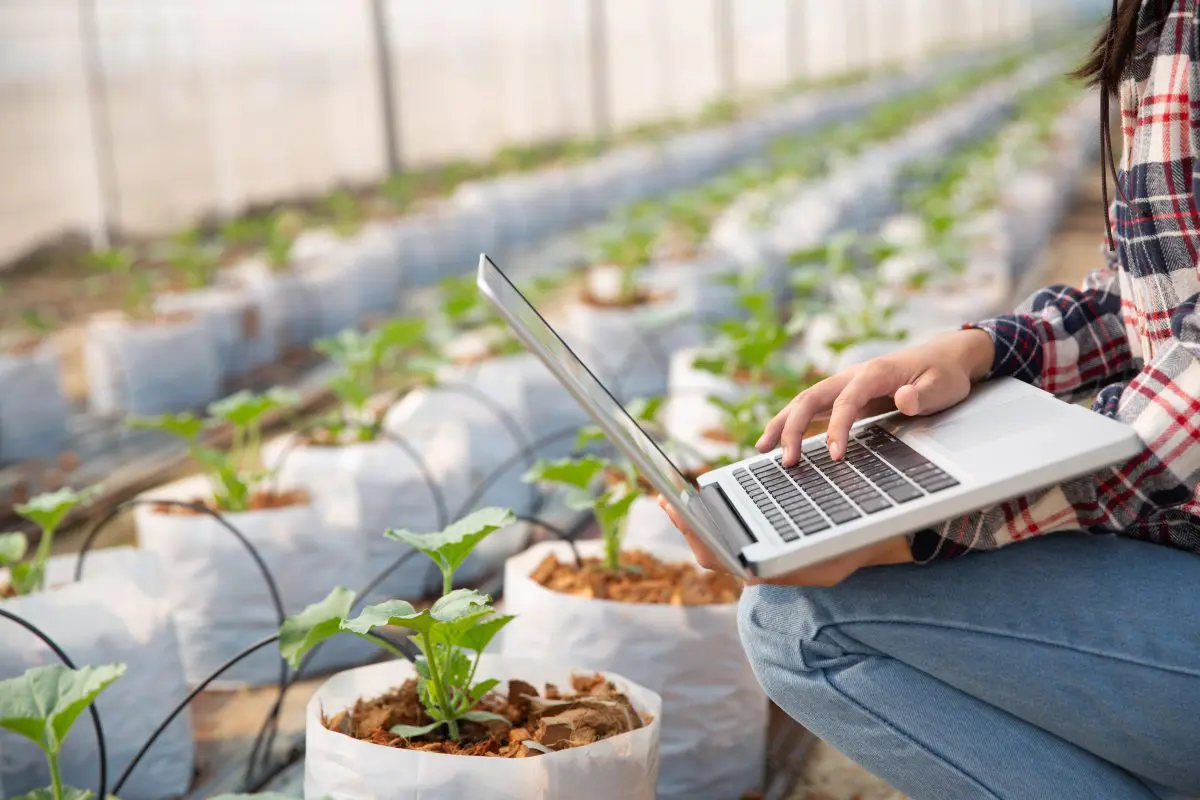
In the age of technology, farming has evolved beyond intuition and hard work. Now, it’s driven by data—lots of it. We call them “big data” – it’s the trendy term in almost every industry. It was introduced in 2005 to describe large, heterogeneous data sets that cannot be processed with traditional data management techniques. But what exactly is big data in agriculture, and how does agriculture software development drive transformation across the sector?
In our blog, we dive into the opportunities this technology offers farmers, researchers, and agri-professionals to efficiently manage resources, boost yields, and contribute to reducing global hunger and poverty.
What Is Big Data in the Context of Agriculture?
In agriculture, the term “big data” refers to the vast amount of information collected from various sources across the farm. By accumulating remotely sensed details like crop health, Leaf Area Index, and soil maps with statistics such as rainfall, temperature, and past yields, big data helps guide decisions on crop choices, yield predictions, fertilizer use, pest control, market trends, and policy making. Cloud technology allows farmers to gather and analyze this extensive information to enable smarter, data-driven farming practices.
Here’s a table that summarizes the key data sources that can drive value from Big Data in agriculture:
| Source | Description |
| Traditional Enterprise Data | Information from daily operations, that helps analyze productivity and efficiency across various farm activities. |
| Sensor Data | Data from field sensors that track temperature, humidity, rainfall, and sunlight, along with inputs from farm machinery. |
| Trade and Financial Data | Market trends and financial forecasts from commodities trading, which give a wider view of potential economic shifts. |
| Weather Data | Weather condition data is crucial for farm activities and reducing risks. |
| Genomic Research Data | Insights from animal and plant genomics, which guide breeding programs and disease management strategies. |
| Drone-Collected Data | Real-time data collected by drones that provide an aerial perspective of the farm for better decision-making. |
| Geospatial and Satellite Data | Satellite images and geospatial data that predict yields and identify potential problem areas on the farm. |
Key Technologies That Power Big Data in Agriculture
In agriculture, big data doesn’t stand alone—technologies like AI, machine learning, IoT, and robotics drive it. These technologies are embraced to gather and process data that enable the development of informed, data-driven solutions that enhance agricultural practices.
Let’s take a closer look at the technologies that are driving big data’s role in agriculture.
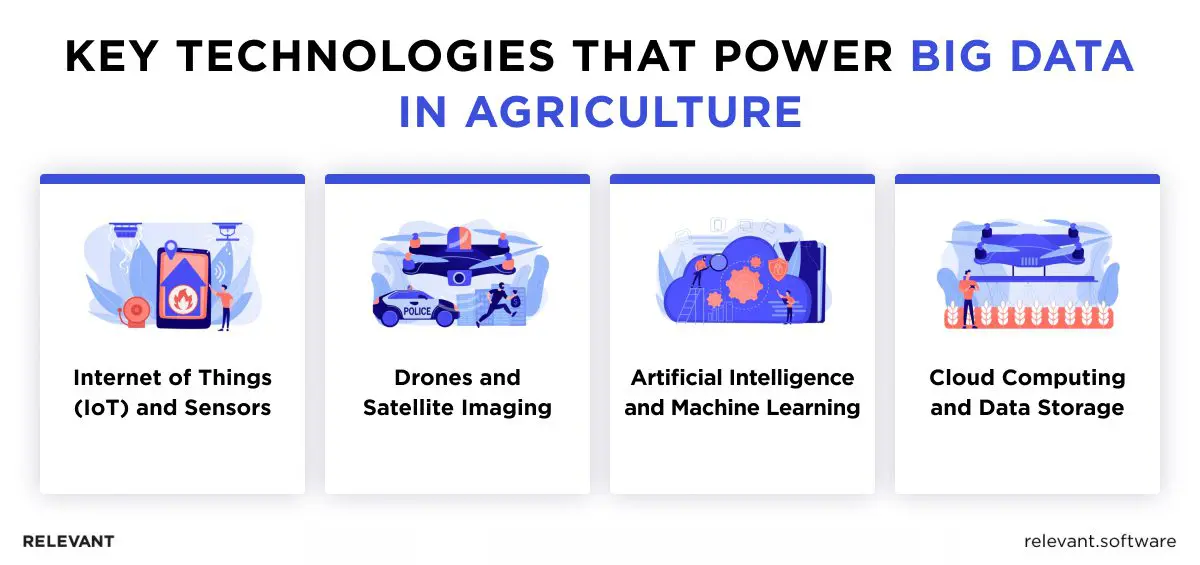
Internet of Things (IoT) and Sensors
At the heart of big data analytics in agriculture are IoT networks, which comprise devices and sensors that are embedded throughout the farm to monitor various conditions in real-time. There are several types of sensors commonly used in agriculture:
- Soil Moisture Sensors: Measure water content in soil to optimize irrigation.
- Light Sensors: Monitor sunlight levels to decide on planting times and shading in greenhouses.
- Temperature Sensors: Record temperature changes in the air and soil to protect crops from weather extremes.
- Nutrient Sensors: Assess soil nutrient levels for precise fertilizer application to improve crop yields.
- pH Sensors: Check soil’s pH to maintain ideal conditions for different crop varieties.
Related – Top 5 Applications of IoT in Agriculture
Drones and Satellite Imaging
Aerial data collection through drones and satellite imaging has revolutionized precision farming. Drones with multispectral and thermal cameras capture images that reveal early signs of crop stress, while satellite imagery monitors large areas over time and tracks crop growth and seasonal changes for better farm management. Together, drones and satellites allow farmers to precisely target problem areas, apply inputs like water, fertilizers, or pesticides only where needed, and improve overall crop yield and efficiency while cutting costs and environmental impact.
Additionally, drones and satellite images offer crucial insights into weather patterns and crop health, which enables farmers to make informed decisions for food safety. This information is readily available online, and it serves as an essential resource for farmers.
Artificial Intelligence and Machine Learning
These are the engines that drive the processing of big data in agriculture. Machine learning algorithms can analyze data from available sources to predict outcomes and suggest actions. For example, by looking at past weather, soil conditions, and how crops have performed, AI can help farmers figure out the best times to plant or harvest, which will lead to better yields and fewer risks. Recent market analysis predicts a significant rise in the global AI in the agriculture market, from $1.5 billion in 2023 to around $11.13 billion by 2032.
Related – How the IoT and AI Are Impacting Agriculture
Cloud Computing and Data Storage
Handling the vast information generated by modern agricultural technologies demands significant computation power. With scalable cloud solutions and cloud-based data applications, farmers can store, process, and access this information from anywhere, eliminating the need for costly on-site infrastructure. This flexibility supports better decision-making, with all crucial details—from weather forecasts to soil analysis—readily available whenever needed.
How to Use Big Data in Agriculture?
Harnessing big data in agriculture can transform how you manage your farm, optimize resources, and boost yields. Let’s explore the steps to effectively leverage big data to enhance your agricultural operations and drive better results.
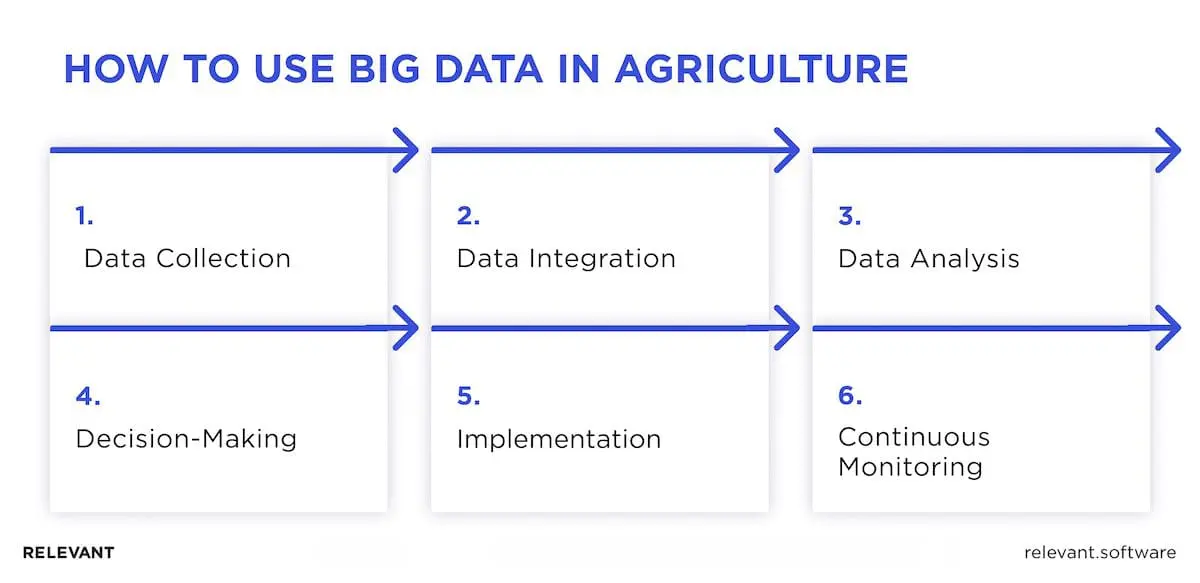
Step 1. Data Collection
Begin by installing sensors in the soil to monitor moisture, temperature, and nutrient levels. Next, use drones or satellite imaging to gather data on crop health, plant growth, and field conditions. Additionally, equip tractors and other farm machinery with sensors to track performance and maintenance needs.
Step 2. Data Integration
Combine data from different sources, such as weather forecasts, soil conditions, and crop health, into a centralized system.
Step 3. Data Analysis
Use data analytics tools to process and interpret the collected data. For instance, analyze weather data alongside soil moisture levels to determine the best times for planting or irrigation.
Step 4. Decision-Making
Use the insights from data analysis to make informed decisions. For example, adjust water and fertilizer use in accordance with real-time soil conditions or anticipate and prevent pest infestations by tracking crop health indicators. This proactive approach enables swift action, reduces waste, improves crop yields, and enhances overall farm management.
Step 5. Implementation
Apply the strategies derived from data analysis. This could mean changes to irrigation schedules, shifts in planting times, or selecting different crop varieties based on predicted weather patterns and soil conditions.
Step 6. Continuous Monitoring
Keep the data collection and analysis process ongoing. Continuously monitor the farm’s performance, making adjustments as new data comes in to maintain optimal conditions for crop growth and farm productivity.
Applications of Big Data in Agriculture
According to a recent study, farms using data-driven techniques can see yield increases of up to 20%. But how exactly is big data applied in agriculture? Let’s explore the practical ways in which farmers are leveraging this technology to boost productivity and efficiency.
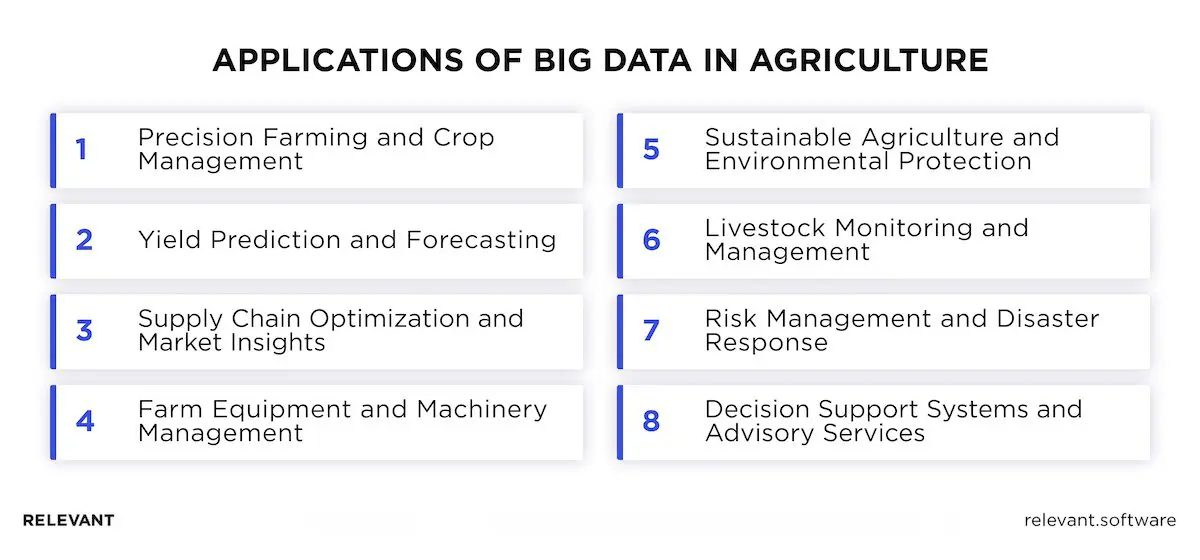
Precision Farming and Crop Management
Big data plays a huge role here. By collecting detailed information from the fields—like soil moisture levels or nutrient content—farmers can tailor their use of water, fertilizers, and pesticides to what the crops actually need.
Think about how farmers used to rely on gut feeling or experience to decide when to water or fertilize their crops. Now, with big data, they can look at real numbers—like soil moisture levels, weather conditions and forecasts, and crop health metrics. This means they use water and fertilizer only when and where it’s really needed, cutting down on waste and boosting yields.
Yield Prediction and Forecasting
Farmers have always tried to predict how much they’ll harvest, but with big data, those predictions get a lot more accurate. Predictive models can forecast how much a field will yield, even before the seeds are sown, by analyzing past weather patterns, soil conditions, and crop performance. For example, a farmer might use data science in agriculture to decide whether it’s worth planting a certain crop this season or how much fertilizer to use.
Supply Chain Optimization and Market Insights
Getting crops from the field to the market involves a lot of steps, and big data helps streamline this process. By analyzing the amount of data from the supply chain—everything from transportation logistics to storage conditions—farmers can make sure their produce gets to the market faster and in better condition.
Farm Equipment and Machinery Management
Farm equipment downtime can be costly, with billions lost annually due to machine failures. With sensors and cameras feeding it data, predictive maintenance can spot potential problems in real-time, which will prevent breakdowns before they happen. For instance, a slight change in vibration or temperature might go unnoticed by the operator, but the system can flag it as an early warning of a potential breakdown.
Sustainable Agriculture and Environmental Protection
Big data allows farmers to protect the environment by making more efficient use of resources and cutting down on waste. This might involve reducing water usage, applying fewer chemicals, or selecting crops that are a better match for the local climate. The goal is to farm in a way that’s good for both the environment and the bottom line, promoting sustainability and profitability. For example, precision irrigation systems driven by big data can reduce water use by up to 30%, a critical improvement in water-scarce regions.
Livestock Monitoring and Management
Keeping an eye on livestock health and productivity is crucial, and the use of big data makes this easier than ever. For example, if a cow isn’t eating as much as usual, the system can flag it so the farmer can check on her before it becomes a serious problem. In one instance, a dairy farm in the Netherlands increased milk production by 12% through the use of big data to optimize feed and milking schedules based on data insights.
Risk Management and Disaster Response
Farming comes with risks—weather, pests, market fluctuations—but big data solutions help manage those risks better. For example, if data shows that a specific area of a field is prone to flooding, it might recommend planting a more water-resistant crop in that location. The goal isn’t to eliminate all risk—something that’s impossible—but to be prepared and have a plan for when issues arise.
Decision Support Systems and Advisory Services
Big data doesn’t just offer raw information; it helps turn that information into practical advice. Decision Support Systems use this information to provide farmers with actionable insights. These agriculture data analytics systems act as expert advisors available 24/7. They help determine the optimal time for planting, manage crop rotations, and suggest market strategies.
The Challenges of Implementing Big Data in Agriculture
To give you a clearer picture of what you might face on your path to data-driven farming, here’s a quick rundown of some common big data in agriculture challenges. As with any new technology, there are hurdles to overcome, but understanding them upfront can help you navigate the journey more smoothly.
Data Privacy and Security Concerns
Data analytics in agriculture involves more than just numbers on a screen—it’s sensitive information about land, crops, and farming practices. Sharing farm data can seem risky. Smallholder farmers may worry about exploitation by larger corporations, while larger farms might fear having their competitive strategies revealed.
Solution: The key is to implement strong data protection measures. Farmers should look for platforms that offer end-to-end encryption and transparent data use policies. It’s also crucial to ensure that data ownership remains with the farmer, which gives them control over how and with whom their data is shared.
Integration and Data Standardization
A less obvious but equally challenging issue is the lack of standardization across different platforms. Farmers often use multiple technologies that don’t always communicate well with each other. Without standardization, information from one sensor might not easily combine with data from another, which leads to fragmented and less useful insights.
Solution: Develop standardized formats and ensure interoperability between platforms. Industry-wide standards for agricultural technology could help in creating a more seamless integration of various information sources.
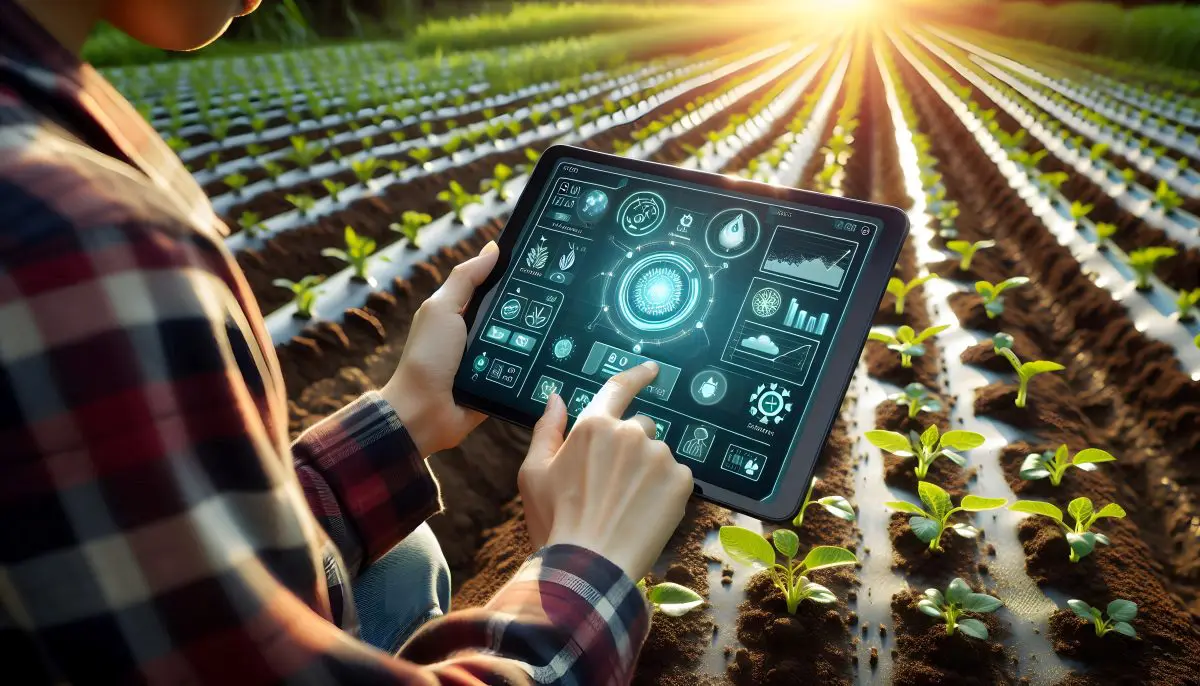
High Costs and Accessibility Issues
Farming isn’t your average business. It’s a field full of wild cards—weather, pests, and market fluctuations, to name a few. And let’s be real: most farms aren’t huge corporations with endless resources. They’re small operations where every penny and every decision counts, making it tough to jump on the high-tech bandwagon.
There’s no getting around it—adopting big data technologies presents challenges—especially the expense involved, which can be prohibitive for small farmers. This includes not only the initial investment in sensors, software, and equipment but also the costs for maintenance and upgrades. On top of that, there’s the issue of accessibility. In many rural areas, the necessary infrastructure, such as reliable internet and power supply, is simply not there. This digital divide leaves many farmers unable to tap into the full potential of big data, either due to cost constraints or limited access to the required technology.
Solution: One approach to making big data more accessible is through cooperative models or government subsidies that reduce the cost burden on individual farmers. Additionally, it’s recommended to develop more affordable, scalable solutions tailored to the needs of smallholders could help bridge the gap.
While solutions exist for all these challenges, what you really need is a reliable tech partner. Someone who, like Relevant, offers AI software development services and can help you navigate these obstacles to get the most out of your data. We’ve been down this road with agricultural businesses before, and the case study below is a good reflection of that experience.
A Smarter Berry Harvest: Our Case Study with Wishfarms
Wishfarms, a top berry supplier based in Florida, came to us with a clear challenge. They needed an app that could withstand the extreme conditions their workers face daily—from the scorching Florida sun to sudden rain showers. However, durability wasn’t the only concern; the app also had to be user-friendly enough for workers wearing gloves and capable of processing hundreds of thousands of scans daily.
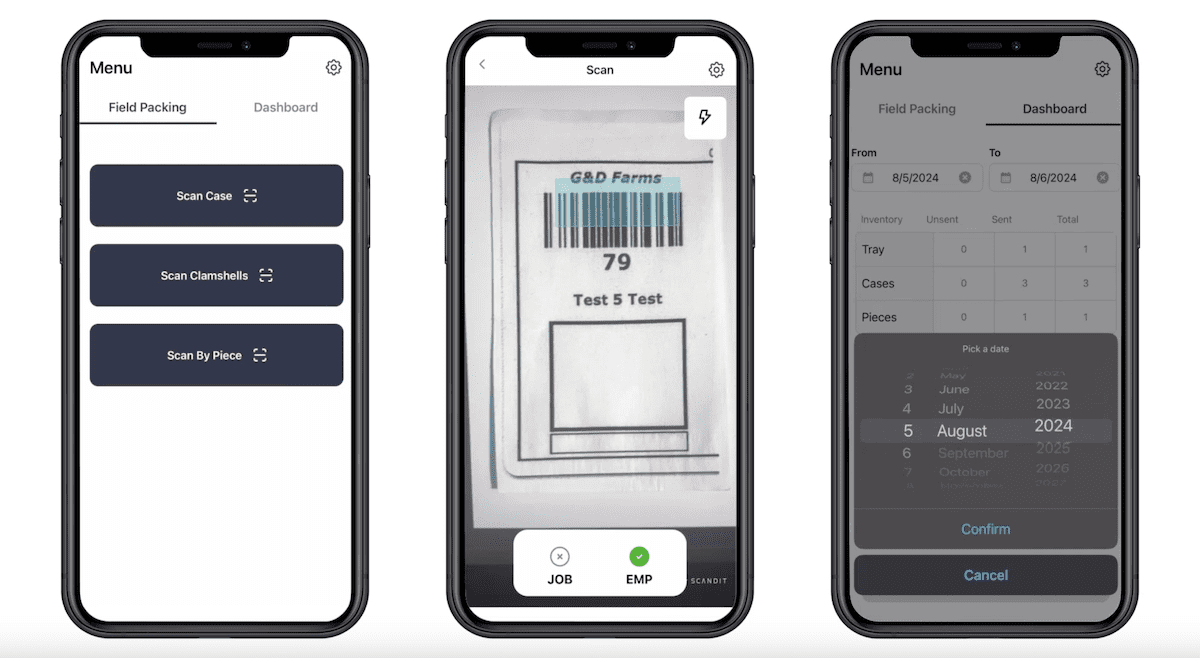
Our project management office took the lead in ensuring that every detail met Wishfarms’ high expectations. Through close collaboration and careful oversight, we developed a React Native app that improved the berry-picking process at Wishfarms. Its intuitive interface, with large, high-contrast buttons, allows workers to navigate effortlessly, even with gloves on. The scanner processes thousands of QR codes and barcodes per hour, come rain or shine. Plus, a training mode has been included to help new users get up to speed without any risk to actual data.
Big Data in Agriculture: Final Words
Imagine you manage a farm or agribusiness and have gathered a wealth of information—spreadsheets that track soil moisture, detailed weather patterns, or even your great-grandfather’s tried-and-true crop rotation strategies. However, possessing this data is only part of the challenge. You need a method to make all that information work for you instead of feeling overwhelmed by it. Given the significant investment in big data infrastructure, prioritizing the maximization of its value should be your goal.
That’s where we at Relevant come in as your trusted partner. We have the tech expertise to transform your data into something more meaningful. Whether you aim to boost your crop yields, fine-tune pesticide use to keep pests at bay or ensure your products move smoothly from farm to table, we’ve got you covered. Contact us to start!



